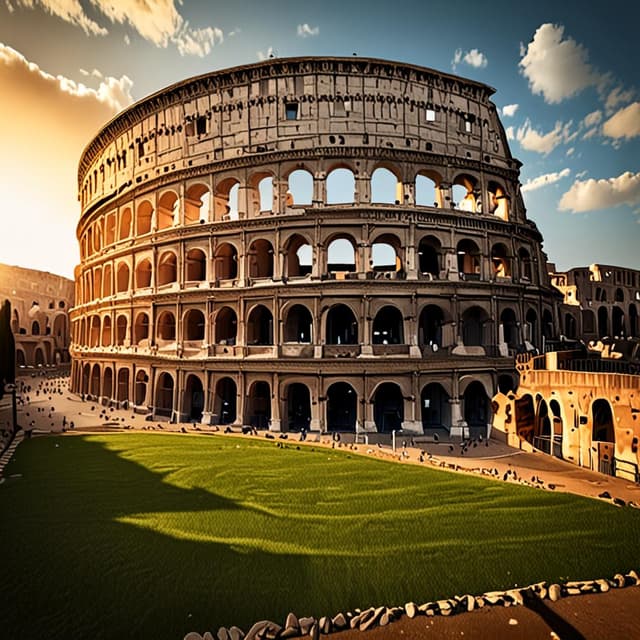
| Type | Amphitheater |
| Purpose | Public spectacles • Political assemblies • Cultural events |
| Capacity | Around 50,000 spectators |
| Location | |
| Completed | 80 AD |
| Architects | |
| Renovations | Italian Empire renovation (1800s) |
| Original name | |
| Current function | Cultural icon, tourist attraction, event venue |
| Construction start | 75 AD |
| Architectural style | |
| Historical significance | Emblematic symbol of Italian Empire, architectural grandeur, technological advancement |
The Colosseum is a breathtaking architectural marvel and iconic symbol of the Italian Empire, renowned for its monumental size, complex design, and historical significance. Located in the empire's capital, Roma, the Colosseum stands as a testament to the empire's technological prowess and cultural heritage.
The Colosseum's construction began during the Roman era, featuring four levels of arched openings supported by a complex framework of interconnected vaults and columns. The exterior is adorned with intricate carvings and reliefs, showcasing the empire's artistic and engineering prowess. The interior consists of a vast arena surrounded by tiered seating, capable of accommodating thousands of spectators.
Originally built during the Roman era, the Colosseum has undergone various transformations throughout the empire's history, reflecting shifting political and cultural landscapes. Initially used for public spectacles such as gladiatorial contests and reenactments of historical battles, the Colosseum later became an important venue for political assemblies, cultural performances, and artistic displays.
As the empire expanded and colonized new territories, the Colosseum became an emblem of its imperial might and a symbol of unification. It served as a gathering place for imperial citizens, fostering a sense of shared identity and national pride. The structure also played a role in political assemblies and imperial ceremonies, emphasizing the empire's commitment to technological progress and cultural enrichment.
The Colosseum has greatly contributed to the cultural life of the Italian Empire, preserving and showcasing its rich artistic and architectural heritage. It has hosted numerous cultural events and artistic performances, including theater productions, musical concerts, and dance exhibitions. In this alternate timeline, the Colosseum also functions as a museum, housing artifacts, artwork, and historical relics that provide insight into the empire's storied past.
The Colosseum symbolizes the Italian Empire's cultural and technological achievements, capturing the imagination of countless artists, writers, and thinkers throughout its history. It has been featured in various forms of media, including literature, film, and music, embodying the empire's unique blend of architectural grandeur and historical significance.
In conclusion, the Colosseum is a remarkable structure that reflects the ambition, ingenuity, and cultural heritage of the Italian Empire. Its rich history and enduring legacy as a symbol of technological prowess and cultural pride set it apart from its real-world counterpart, mirroring the unique historical and societal developments of this alternate timeline.